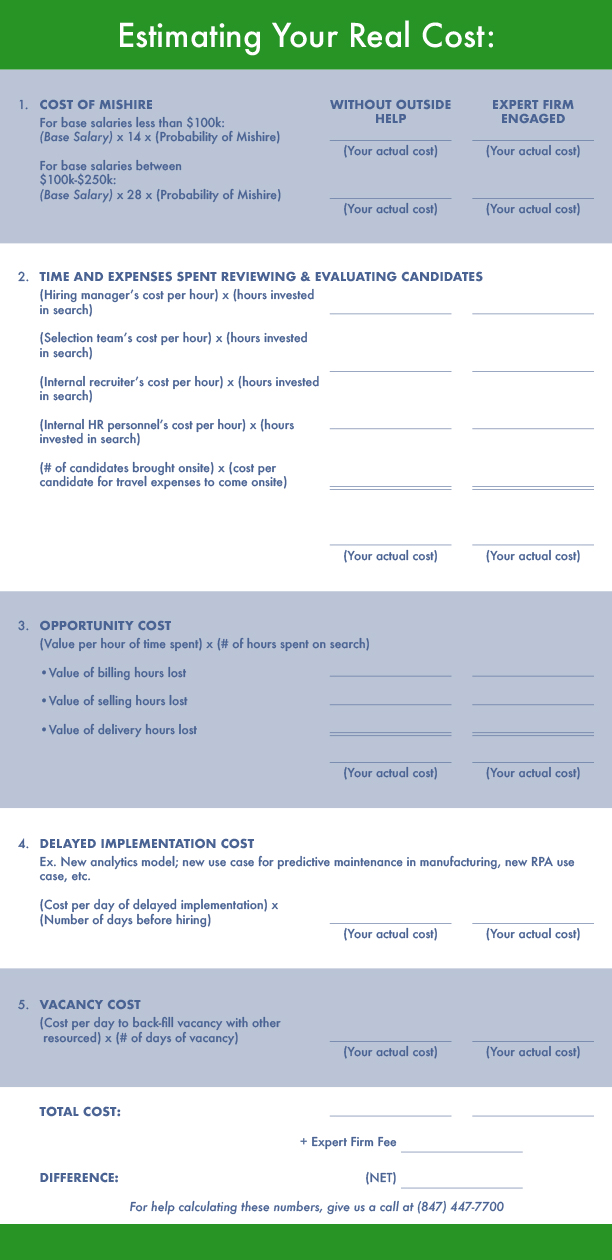The Real Cost of Your Essential Hires
For decades, the world’s best companies have utilized retained search firms to hire their top executives. This is because they know that making a great hire versus a mediocre hire at this level is critical, and the cost of making a mis-hire can be catastrophic. But what about your company’s essential hires? You know, those Senior Manager and Director-level hires that your company has deemed essential — who will be on the front lines delivering on your company’s strategy, leading your company’s digital transformation or ERP initiative, possibly even in a role that represents a new capability for your organization such as data science, intelligent automation/RPA, or digital manufacturing. Essential hires represent one of the most important business decisions you’ll ever make. Now, more than ever, it’s important to know… How can I reduce the real cost of making my essential hires?
When beginning the hiring process for these positions, many organizations feel as if they should attempt to handle the search internally before engaging an outside firm. This feeling is most often based on one or more of the following assumptions:
- The cost of engaging an outside firm to conduct the search will be greater than the cost to handle the search internally;
- All hires are equal;
- Nobody from an outside firm could possibly understand the role and how to succeed in it better than people within the organization;
- The internal talent acquisition team’s interests are better aligned with the hiring manager’s than the interests of an outside firm.
Wanting to handle hiring internally for an essential hire is often founded in a genuine desire to be a good steward of an organization’s time and resources. But are these assumptions about engaging an outside firm correct?
Your Real Cost
In the real world of recruitment, mis-hires are unfortunately common. A study from Gallup indicated that companies fail to choose the candidate with the right talent for the job a staggering 82% of the time,[1] and The Recruiting Roundtable stated that “Selection decisions are often about as accurate as a coin flip. Fifty percent of the time, they are regretted.”[2] The frequency with which organizations miss the mark when hiring can bring significant costs, ranging from a loss of up to 14 times the base salary of an employee earning less than $100k to up to 28 times the base salary of an employee earning between $100k and $250k according to Recruiting Roundtable [3].
What is a hiring manager’s time worth? The typical Director at a Fortune 1000 company costs their company between $120 and $200 per hour and the typical VP between $200 and $325 per hour. Let’s imagine the hiring manager is a VP and they have an interview panel of two Directors and three VPs. If the hiring manager spends an average of four hours evaluating each candidate they select to interview before they make their final hiring decision and the rest of the panel spends two, then each candidate that makes it through the process costs the organization between $2,500 and $4,000 just to be evaluated by this group. Evaluate four candidates and your organization has spent $10,000 to $16,000, evaluate eight and you have spent $20,000 to $32,000! And this is before considering any other internal costs, such as how much time other members of your organization spends with each candidate, how much time your hiring manager spends reviewing resumes and the costs of bringing candidates onsite to meet with you in person.
Besides these direct costs, what are the opportunity costs of a hiring manager’s time? If you’re a consulting firm, every hour an associate spends interviewing is in an hour that the associate didn’t spend billing or developing new business. If you’re a technology leader in a Fortune 1000 company, every hour spent on your search is an hour not spent delivering on a project that could be driving your company forward.
Furthermore, what’s the cost of a position left unfilled? If you’re a consulting firm that charges $300 an hour, it’s $2,400 a day (or $50,000 a month) in lost billings alone for billable consultants. If you’re a Fortune 1000 company backfilling that role with a contractor or consultant that costs two to three times your future employee, it’s $800 to $1,600 a day ($18,000 to $36,000 a month) plus expenses for positions with a $150,000 annual salary.
Most organizations calculate cost per hire by simply dividing all their recruiting costs by the number of hires made in a specific period. But all searches are not created equal. What’s your internal search really costing you if it…
- Increases your likelihood of making a mis-hire;
- Causes your hiring managers to spend more time on it;
- Prevents your hiring managers from spending more time billing, selling, or delivering products or services to your company and its customers;
- Delays your implementation of valuable products or services;
- Prolongs your use of more expensive resources?Calculate Your Real Cost
Click the image for your customized worksheet.

All Hires are Not Equal
Just as all searches are not equal, neither are all hires. When it comes to essential hires, now more than ever “good enough” isn’t good enough. When an organization is searching for candidates who will be operating in one of those Senior Manager or Director-level roles – again, one of those individuals who will be on the front lines delivering on your company’s strategy, leading your company’s digital transformation or ERP initiative, possibly even in a role that represents a new capability for your organization such as data science, intelligent automation/RPA, or digital manufacturing – their goal should be to discover and acquire an A-level performer. Why? According to Accel KKR, “A-level performers…”[6]
- Are 3 to 5 times more productive with a significantly greater impact on both the top and the bottom line of an organization.
- Increase team engagement and actively participate in the organization’s culture. It has been suggested that managers account for at least 70% of the variance in employee engagement.[7]
- Positively impact management through:
- Less time spent at work because A-level performers quickly show they don’t need to be micromanaged.
- Less time spent reviewing their work; A-level performers get it right the first time.
- More innovation; A-level performers bring a fresh perspective that helps drive organizational initiatives forward.
- Building positive relationships with both employees and customers.
What Causes Success is a Mystery to Most
The idea that organizations inherently understand roles better than an outside firm can is a myth. This may sound harsh, but consider the following facts:
- 66% of hiring managers come to regret their interview-based hiring decisions, according to DDI;
- 40% of newly promoted managers and executives fail within 18 months of starting a new job, according to Manchester, Inc.;
- As noted earlier, a study from Gallup indicated that companies fail to choose the candidate with the right talent for the job 82% of the time;
- A survey from Glassdoor found that 69% of hiring companies made a bad hiring decision based on a flawed interview process, with 22% reporting insufficient talent intelligence prior to recruiting.[7]
Another, relevant myth: human beings are rational and logical decision makers. Real decision-making is rapid, biased, and subconscious. Numerous cognitive neuroscientists have conducted studies that revealed that only 5% of our cognitive activities (decisions, emotions, actions, and behaviors) are conscious, whereas the remaining 95% is being generated in a non-conscious manner. The truth is that humans rationalize their decisions after the fact. So, what’s really going on when someone says, “I knew they were the right person for the job in the first two minutes”? They made an immediate, biased decision at the subconscious level and spent two minutes rationalizing it!
Consider this recent quote from Google:
“We looked at tens of thousands of interview results… and how that person ultimately performed in their job. We found zero relationship. It’s a complete random mess.”
Alignment of Interests
Internal Recruiters
According to SHRM internal recruiters work an average of 30-40 searches simultaneously, and the median is 15-20.[4] Furthermore, some estimates indicate that internal recruiters spend as much as 60% of their time in administrative tasks such as non-recruiting phone calls and emails, scheduling interviews, training and education, and internal meetings and initiatives. In other words, the average internal recruiter working a 40-hour week has less than 30 minutes each week to work on each search. Sure, one can increase these metrics by 50% for that corporate recruiter willing to put in 12-hour days and 60-hour work weeks. However, that will still only result in one and a half to three hours a week per search, and workload is cited as one of the reasons that 90% of all corporate recruiters turn over in the first 12 months.[5]
A key metric for all recruiters is time-to-fill. As a result, internal recruiters must carefully choose where they spend their limited time or risk causing the searches that are easier to fill to take longer as they get bogged down on the more unique, highly competitive and hard to fill searches (such as your new data science, ERP, or digital manufacturing search). Also, when a role is brand-new to a recruiter, how do they determine if the position they are about to work on is going to be one of the easier ones or one of the more difficult ones? Lastly, because corporate recruiters often have heavy search loads, they rely heavily on their hiring managers to define their roles and vet their candidates.
Contingency Firms, RPOs, and Retained Search Firms
Contingency firms are only paid if you pick their candidate. As a result, their incentive is to see their candidate get placed, whether that be at your company or someone else’s. The typical recruiter at a contingency firm works 20-30 searches simultaneously, and in short bursts.
RPOs are paid by the hour. As such, they are incented to bill hours and keep costs down in order to optimize margins. The recruiters at RPOs, like their corporate recruiter counterparts, work an average of 30-40 searches simultaneously with a median of 15–20.
Retained search firms are paid a fixed amount, typically at the beginning, middle, and end of the engagement based upon a position’s compensation, to develop and manage the entire search process. As such, their incentive is to see your project completed successfully. The Partner at your typical retained search firm works an average of 3–5 searches simultaneously.
Conclusion
If one wants to responsibly manage their company’s resources, what should they do? Don’t wait. Pick the right partner for your essential hire, right from the start. Waiting won’t just chew up the valuable time of your internal recruiters, executives, and their peers; it will cost your organization more money and produce less predictable results. Selecting who gets hired for one of those Senior Manager or Director-level roles will be one of the most important business decisions that executive will ever make.
About iHs Retained Search
It is rare that a person’s “basic/natural self” (the way we behave without any outside pressure for adjustment) is thoughtfully and intentionally aligned with an organization’s new roles and ways of working. It is also uncommon for leaders and teams to possess a mutual understanding of the similarities and differences of the basic/natural selves of team members and how they work best together to create a high-performing team.
iHs combines a deep understanding of human dynamics with expertise in behavioral assessment tools – such as PDP – with their Partners’ peer level technology and leadership experience and expertise gained from the completion of thousands of technology search and leadership development engagements to help their clients:
- Discover and Acquire Technology Leaders and Key Contributors that Succeed
- Create the Digital Technology Organization for tomorrow
- Improve the Performance of Technology Leaders and Teams
- Succeed at Leadership Transitions
Through over one thousand engagements over the last 10 years, iHs has delivered the following results:
- Over 90% of the time clients rate the candidates placed through an iHs search or leadership transition engagement a 9 or 10 out of 10 when ask to rate the candidate’s performance;
- 92% of the time iHs changes or significantly enhances the job description that their client started with, and 100% of the time this job description is translated into a competency model;
- Over 90% of the candidates selected through an iHs search are passive and only evaluating their client’s opportunity;
- iHs’ clients, on average, only evaluate 3 to 4 candidates before making an offer that is accepted and iHs has a 98% offer acceptance rate.
As a result, iHs’ clients often partner with them exclusively to make their Senior Manager and Director-level hires.
Testimonials from iHs’ clients:
“Wow, after 90 days on the job, I barely feel as if I need to manage the person you helped us place in this new role. They just naturally do what I hope that they will be doing every day with very little input from me. Their customers are delighted!” – Senior Manager at a Fortune 1000 company
“This was enlightening. Now I understand why no matter how much clear direction and positive and constructive feedback I was giving several of my leaders they never consistently did what I and their customers were hoping they would. Even though they were outstanding performers in their previous roles, who they are naturally just isn’t the right fit for their current role.” – VP of IT at a Fortune 500 company
“You have great knowledge of what is working out there and what is not and use that knowledge to help me better understand what we should be looking for.” – Director of IT at a Fortune 500 company
“iHs does searches the way I would, if I had the time to.” – Talent Acquisition Senior Manager at a Fortune 1000 company
At iHs, the mission is human flourishing. Our goal isn’t just to ensure the speed, efficiency, and quality of our work, but to see people go to work inspired and come home satisfied. To learn more or to start a conversation, visit iHs’ website at https://www.ihsrs.com or give iHs a call at (847) 447-7700.
To learn more or to start a conversation, give us a call at (847) 447-7700.
____________________________________________________________
Sources:
[4] Gallup: Why Great Managers Are So Rare
[5] ERE: 50% of New Hires Fail
[6] Forbes: 5 Tips for Recruiting the Best Employees


